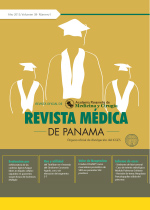Nuevo caso de rickettsiosis humana en Panamá: primer reporte proveniente de un área silvestre
Autores/as
DOI:
https://doi.org/10.37980/im.journal.rmdp.2013123Resumen
Se reporta un nuevo caso de rickettsiosis proveniente de un paciente femenino que laboraba como investigadora en una zona silvestre del área del canal de Panamá. El vínculo epidemiológico, con el antecedente de picaduras por garrapatas facilitó el diagnóstico, el cual se corroboró por medio de serología, utilizando anticuerpos aislados a partir de cepas de Rickettsia rickettsii y Rickettsia amblyommii. Se observó seroconversión IgM e IgG contra Rickettsia del grupo de las fiebres manchadas, en muestras tomadas a los 10 días de inicio de los síntomas y a los 24 días. Paralelamente se hizo una visita a la casa de la afectada, con el fin de descartar el origen doméstico de la infección y conocer si otros familiares tenían o habían presentado síntomas similares. Al perro de la paciente se le extrajo muestras (ectoparásitos y sangre), las cuales fueron analizadas por métodos moleculares y serológicos. No se encontraron evidencias de infección en el perro y no se dieron otros casos similares en la familia. Estos hallazgos sugieren que la transmisión de originó en el bosque donde labora la afectada, lo que haría posible que sea el primer caso de fiebre manchada dentro de un área silvestre de Panamá.
Abstract
We are informing of a new case of rickettsiosis. The patient was an investigator in the woods of the Panama Canal area. This condition, and the fact that she had been bitten by ticks, made the diagnosis easier. This was confirmed by serology, using antibodies isolated from cultures strains of Rickettsia rickettsii y Rickettsia amblyommii. We observed serum conversion IgM and IgG against Rickettsia of the group of the spotted fever in samples taken at 10 and 24 days after the initial symptoms. At the same time, we visited the home of the patient, in order to out rule a domestic origin of the infection and to find out if other members of the family had, at the present or in the past, similar symptoms. Samples were taken from the patient´s dog (blood and ectoparasites). These samples were analyzed by molecular and serological methods. We did not find evidences of infection in the dog and no other similar cases were found in the family. The findings suggest that the patient’s infection came from the Woods where she was working and that this is the first case of spotted fever acquired in a wild area in Panama.
Key words: Rickettsiosis, serology, wild area, Panama.
Publicado
Número
Sección
Licencia
Derechos autoriales y de reproducibilidad. La Revista Médica de Panama es un ente académico, sin fines de lucro, que forma parte de la Academia Panameña de Medicina y Cirugía. Sus publicaciones son de tipo acceso gratuito de su contenido para uso individual y académico, sin restricción. Los derechos autoriales de cada artículo son retenidos por sus autores. Al Publicar en la Revista, el autor otorga Licencia permanente, exclusiva, e irrevocable a la Sociedad para la edición del manuscrito, y otorga a la empresa editorial, Infomedic International Licencia de uso de distribución, indexación y comercial exclusiva, permanente e irrevocable de su contenido y para la generación de productos y servicios derivados del mismo. En caso que el autor obtenga la licencia CC BY, el artículo y sus derivados son de libre acceso y distribución.






